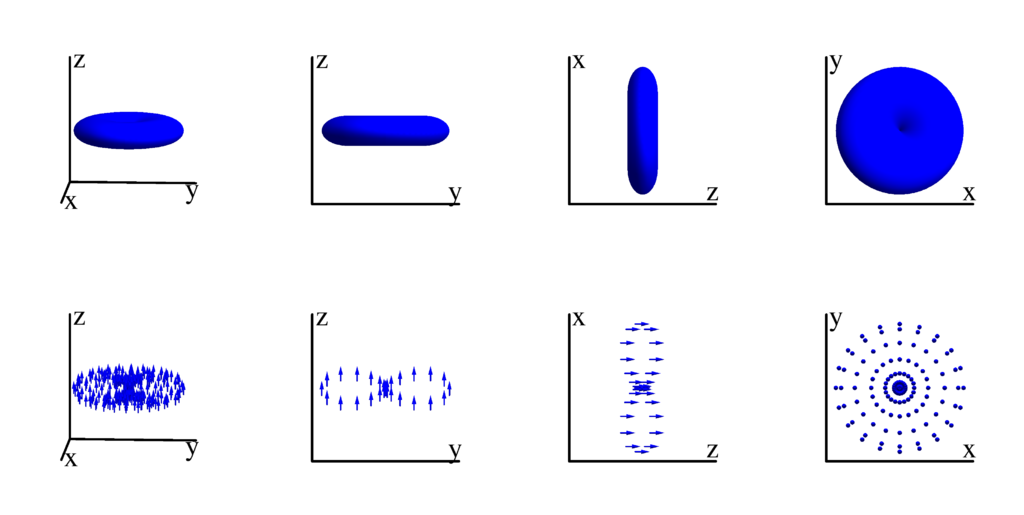Spin-orbit coupled states (J)
Download a notebook that generates this page
The $j$-$j_z$ coupled states are the eigen-orbitals of the spin-orbit coupling Hamiltonian. For the basis sets on harmonics we did not discuss spin, as the basis states for spin up are the same as the basis states for spin down. The spin-orbit coupled states however have spin explicitly included. The $j$-$j_z$ states are defined as: $$ J_{l,j}^{(j_z)} = \left( \begin{array}{c} (-1)^{l-1/2+j_z} \sqrt{2j+1} \left(\begin{array}{ccc} l &\phantom{-}1/2 & j \\ j_z+1/2 & -1/2 &-j_z \\ \end{array}\right) Y_{l}^{(j_z+1/2)}\\ (-1)^{l-1/2+j_z} \sqrt{2j+1} \left(\begin{array}{ccc} l &\phantom{-}1/2 & j \\ j_z-1/2 &\phantom{-}1/2 &-j_z \\ \end{array}\right) Y_{l}^{(j_z-1/2)}\\ \end{array} \right) $$ These wave-functions have two parts, a spin-up and a spin-down part. The explicit form of the wave-function is given as a vector of length 2. The spin-down is the first / top element of this vector, the spin up the second / bottom part of this vector. Note that the wave-function vector of length 2 is not the same as the spin vector. The spin is a vector of length 3 defining the magnetic moment in real space. On first sight it might seem confusing how a wave-function with only two components can define a vector in real space with 3 components. There is not enough information to define a fully general vector. The reason is that the length of the spin is constant in space. The relation between the wave-function and the spin is given by the Pauli matrices. (Note that Pauli defined the order of the spin to be up down, whereas Quanty uses down up. -- sorry this is an order I took during the time I was a student, not realizing the consequences and the entire code is written consistent with this choice --). We define the spin operators as: $$ \begin{align} S_x &= \left( \begin{array}{cc} 0 & \frac{1}{2} \\ \frac{1}{2} & 0 \\ \end{array} \right) ,\\ S_y &= \left( \begin{array}{cc} 0 & \frac{\mathrm{i}}{2} \\ -\frac{\mathrm{i}}{2} & 0 \\ \end{array} \right) ,\\ S_z &= \left( \begin{array}{cc} -\frac{1}{2} & 0 \\ 0 & \frac{1}{2} \\ \end{array} \right),\\ \end{align} $$ and the spin-vector is defined as: $$ \begin{align} \vec{S}(x,y,z) = \{&\psi(x,y,z)^* \cdot S_x \cdot \psi(x,y,z),\\\nonumber&\psi(x,y,z)^* \cdot S_y \cdot \psi(x,y,z),\,\psi(x,y,z)^* \cdot S_z \cdot \psi(x,y,z)\}, \end{align} $$ with $\psi(x,y,z)$ a vector of length $2$ (each element of this vector is a function of the position $(x,y,z)$) and the spin-operators two by two matrices. The length of the spin vector normalized to the local charge density is constant: $$ \frac{\sqrt{\vec{S}(x,y,z)\cdot\vec{S}(x,y,z)}}{\psi(x,y,z)^*\cdot\psi(x,y,z)}=\frac{1}{2}. $$
The following table shows the $J_{l,j}^{(j_z})$ states. We order them first according to $l$. For each $l$ we first list the states with $j=l-1/2$ and then the states with $j=l+1/2$. Within each $j$ shell we order the states from $j_z=-j$ to $j_z=j$. In the plots we show in the top row the surface given by the equation $r={J_{l,j}^{(j_z)}}^* \cdot J_{l,j}^{(j_z)}$ where the $\cdot$ refers to a normal dot-product of vectors. The color is according to the spin with red relating to spin-up and blue to spin-down. The vector $\{1,0\}$ would thus show as a red sphere, the vector $\{0,1\}$ as a blue sphere and the vector $\{\sqrt{1/2},\sqrt{1/2}\}$ as a grey sphere. All spheres in this example would have the same radius 1. We show a 3D image as well as a projection along the $x$, $y$ and $z$ direction. In the second row we show a plot of $\vec{S}(x,y,z)$. This is a vector with length $1/2$ which direction varies in space. We show the vectors on the same surface and using the came color scheme as shown in the top row. For the x and y projection we only show the plane with $x=0$ or $y=0$ respectively.
$l=0$
$j=\frac{1}{2}$
$j_z=-\frac{1}{2}$
$$J_{l=0, j=\frac{1}{2}}^{(j_z=-\frac{1}{2})}=\left( \begin{array}{c} \frac{1}{2 \sqrt{\pi }} \\ 0 \\ \end{array} \right)$$
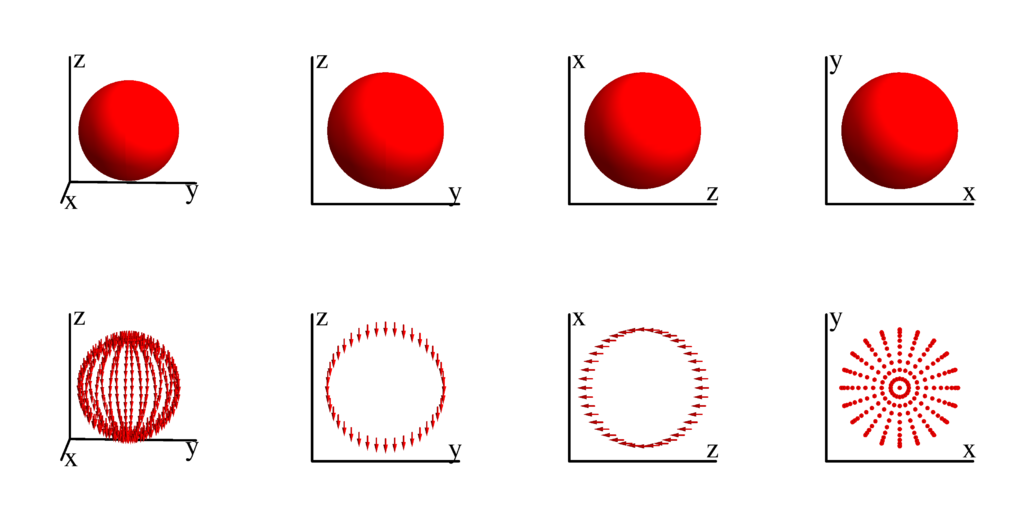
$j_z=\frac{1}{2}$
$$J_{l=0, j=\frac{1}{2}}^{(j_z=\frac{1}{2})}=\left( \begin{array}{c} 0 \\ \frac{1}{2 \sqrt{\pi }} \\ \end{array} \right)$$
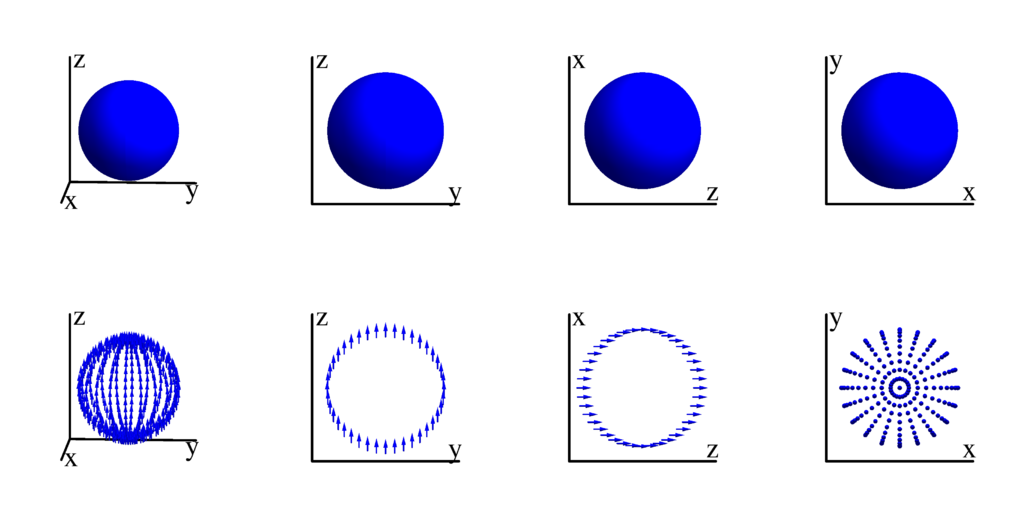
$l=1$
$j=\frac{1}{2}$
$j_z=-\frac{1}{2}$
$$J_{l=1, j=\frac{1}{2}}^{(j_z=-\frac{1}{2})}=\left( \begin{array}{c} \frac{z}{2 \sqrt{\pi }} \\ \frac{i (y+i x)}{2 \sqrt{\pi }} \\ \end{array} \right)$$
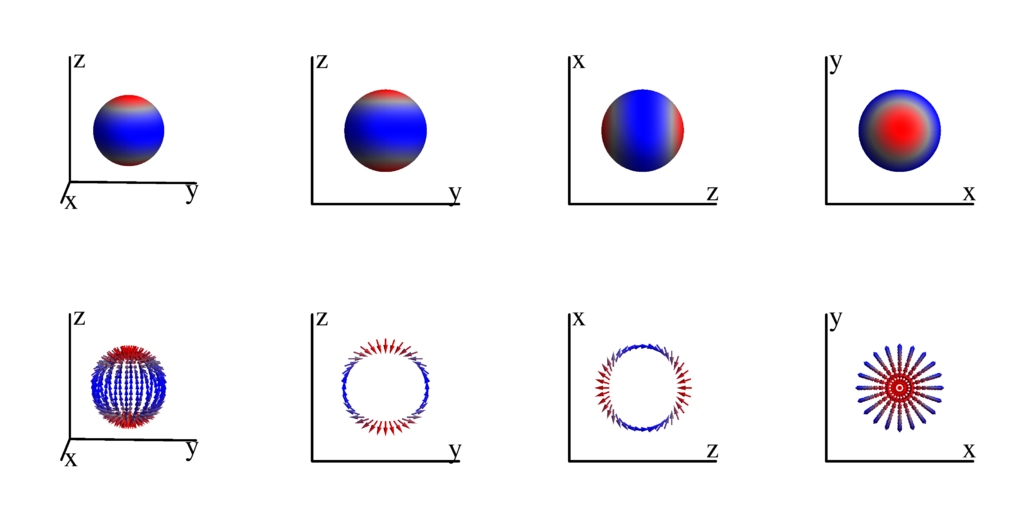
$j_z=\frac{1}{2}$
$$J_{l=1, j=\frac{1}{2}}^{(j_z=\frac{1}{2})}=\left( \begin{array}{c} \frac{-x-i y}{2 \sqrt{\pi }} \\ -\frac{z}{2 \sqrt{\pi }} \\ \end{array} \right)$$
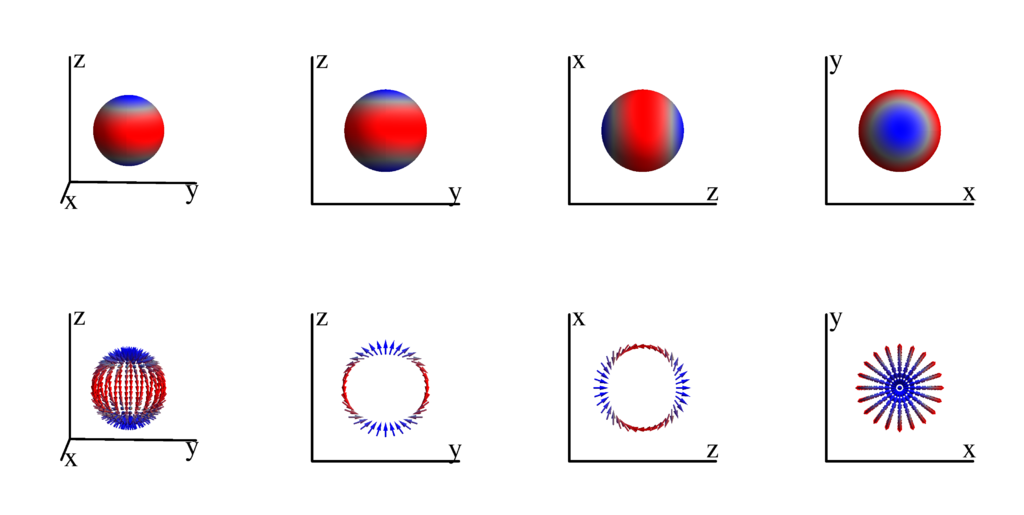
$j=\frac{3}{2}$
$j_z=-\frac{3}{2}$
$$J_{l=1, j=\frac{3}{2}}^{(j_z=-\frac{3}{2})}=\left( \begin{array}{c} \frac{1}{2} \sqrt{\frac{3}{2 \pi }} (x-i y) \\ 0 \\ \end{array} \right)$$
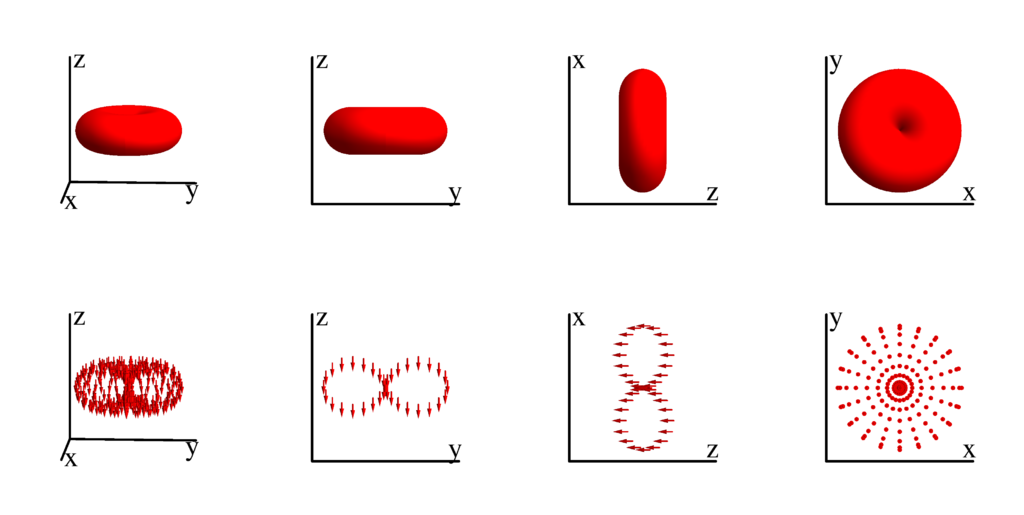
$j_z=-\frac{1}{2}$
$$J_{l=1, j=\frac{3}{2}}^{(j_z=-\frac{1}{2})}=\left( \begin{array}{c} \frac{z}{\sqrt{2 \pi }} \\ \frac{x-i y}{2 \sqrt{2 \pi }} \\ \end{array} \right)$$
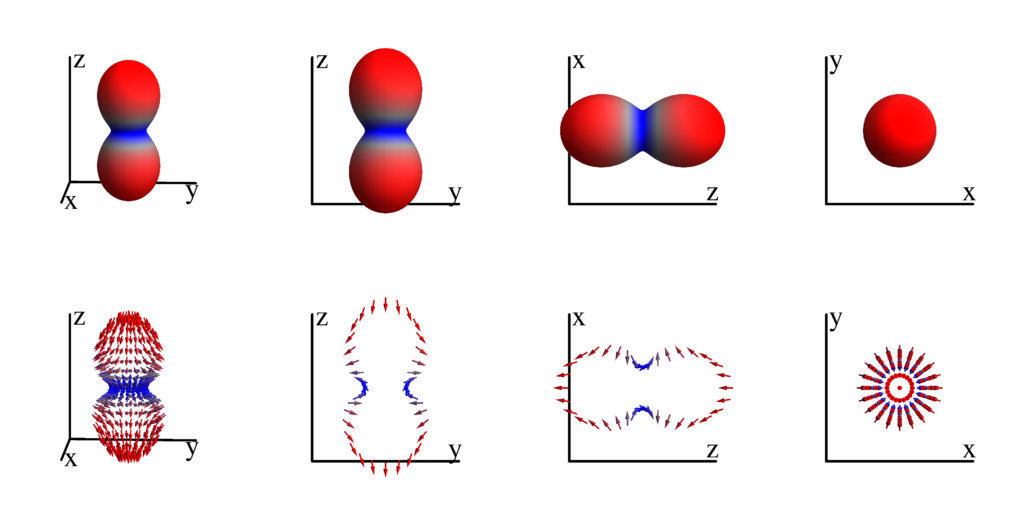
$j_z=\frac{1}{2}$
$$J_{l=1, j=\frac{3}{2}}^{(j_z=\frac{1}{2})}=\left( \begin{array}{c} -\frac{x+i y}{2 \sqrt{2 \pi }} \\ \frac{z}{\sqrt{2 \pi }} \\ \end{array} \right)$$
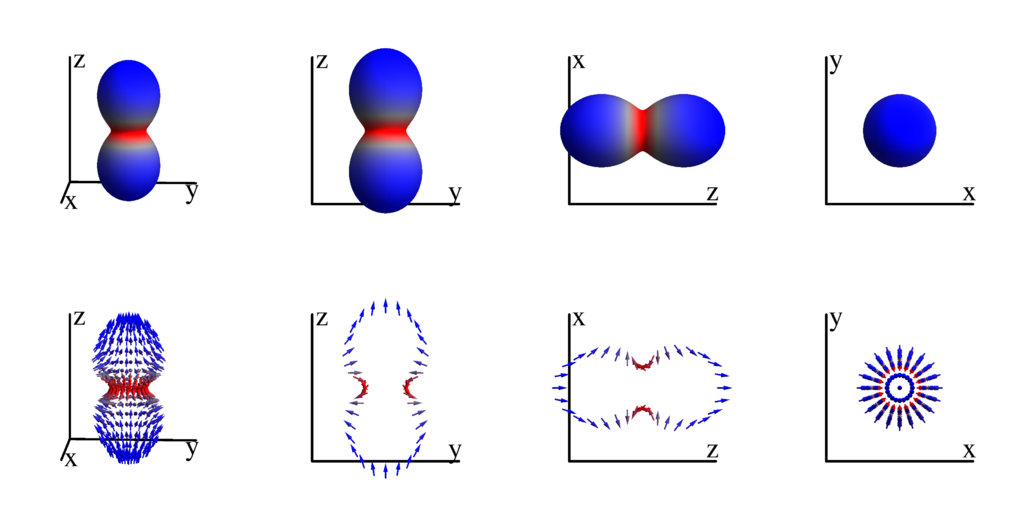
$j_z=\frac{3}{2}$
$$J_{l=1, j=\frac{3}{2}}^{(j_z=\frac{3}{2})}=\left( \begin{array}{c} 0 \\ -\frac{1}{2} \sqrt{\frac{3}{2 \pi }} (x+i y) \\ \end{array} \right)$$
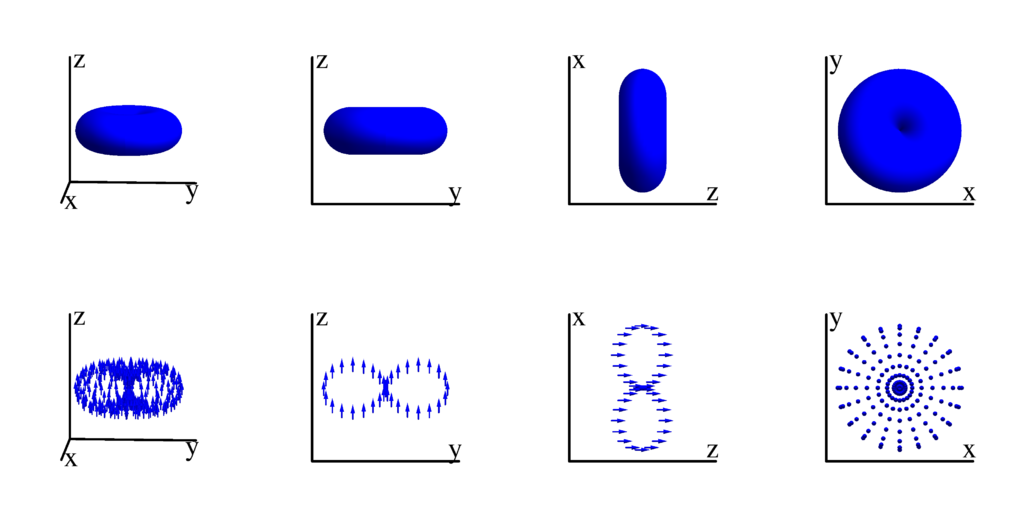
$l=2$
$j=\frac{3}{2}$
$j_z=-\frac{3}{2}$
$$J_{l=2, j=\frac{3}{2}}^{(j_z=-\frac{3}{2})}=\left( \begin{array}{c} \frac{1}{2} \sqrt{\frac{3}{2 \pi }} z (x-i y) \\ -\frac{1}{2} \sqrt{\frac{3}{2 \pi }} (x-i y)^2 \\ \end{array} \right)$$
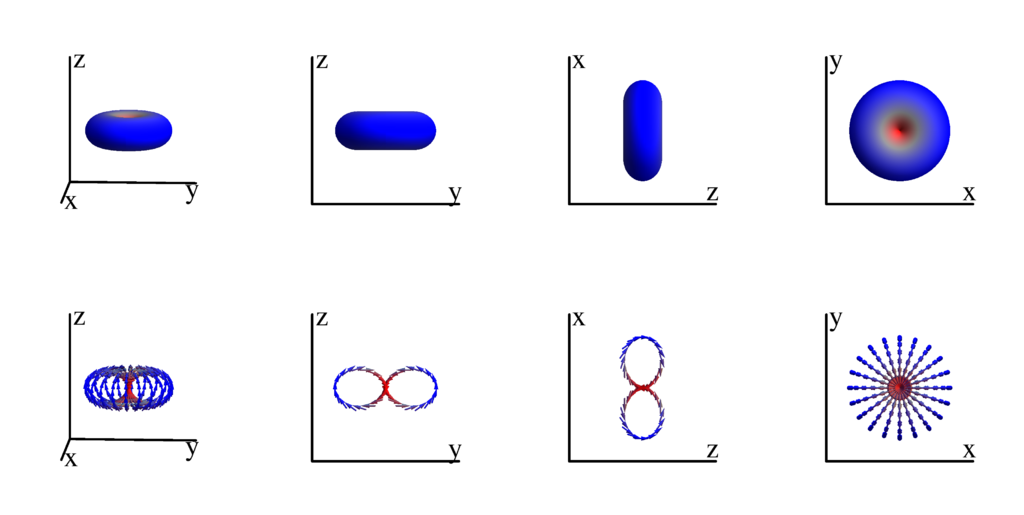
$j_z=-\frac{1}{2}$
$$J_{l=2, j=\frac{3}{2}}^{(j_z=-\frac{1}{2})}=\left( \begin{array}{c} -\frac{x^2+y^2-2 z^2}{2 \sqrt{2 \pi }} \\ -\frac{3 z (x-i y)}{2 \sqrt{2 \pi }} \\ \end{array} \right)$$
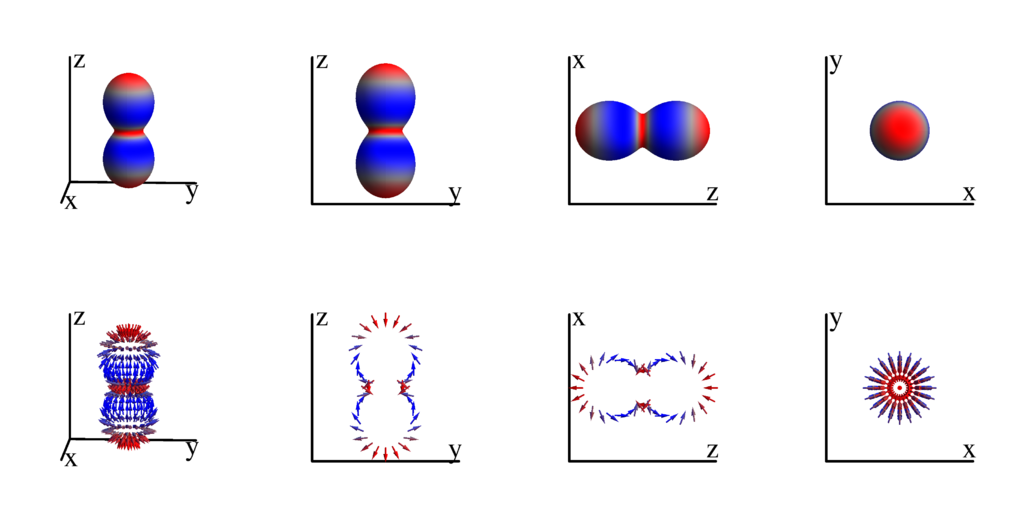
$j_z=\frac{1}{2}$
$$J_{l=2, j=\frac{3}{2}}^{(j_z=\frac{1}{2})}=\left( \begin{array}{c} -\frac{3 z (x+i y)}{2 \sqrt{2 \pi }} \\ \frac{x^2+y^2-2 z^2}{2 \sqrt{2 \pi }} \\ \end{array} \right)$$
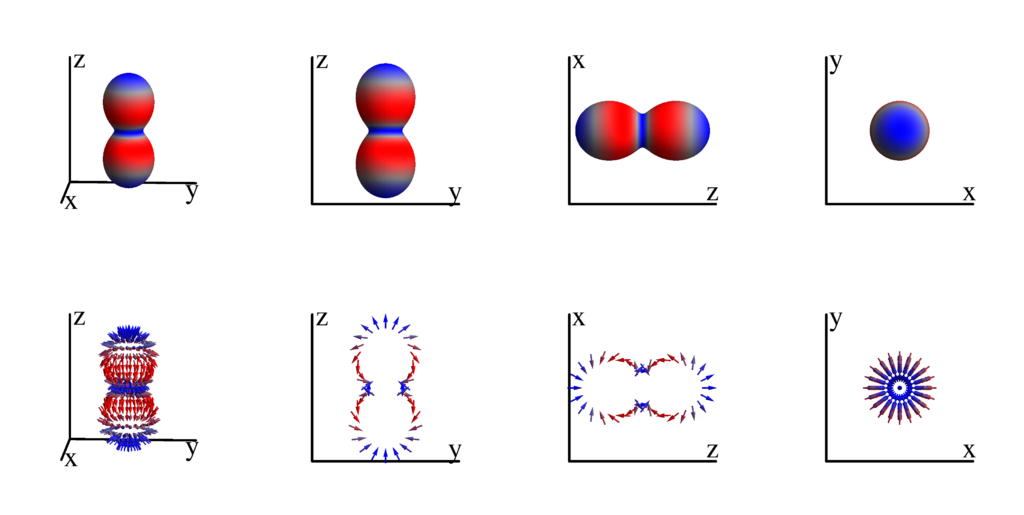
$j_z=\frac{3}{2}$
$$J_{l=2, j=\frac{3}{2}}^{(j_z=\frac{3}{2})}=\left( \begin{array}{c} \frac{1}{2} \sqrt{\frac{3}{2 \pi }} (x+i y)^2 \\ \frac{1}{2} \sqrt{\frac{3}{2 \pi }} z (x+i y) \\ \end{array} \right)$$
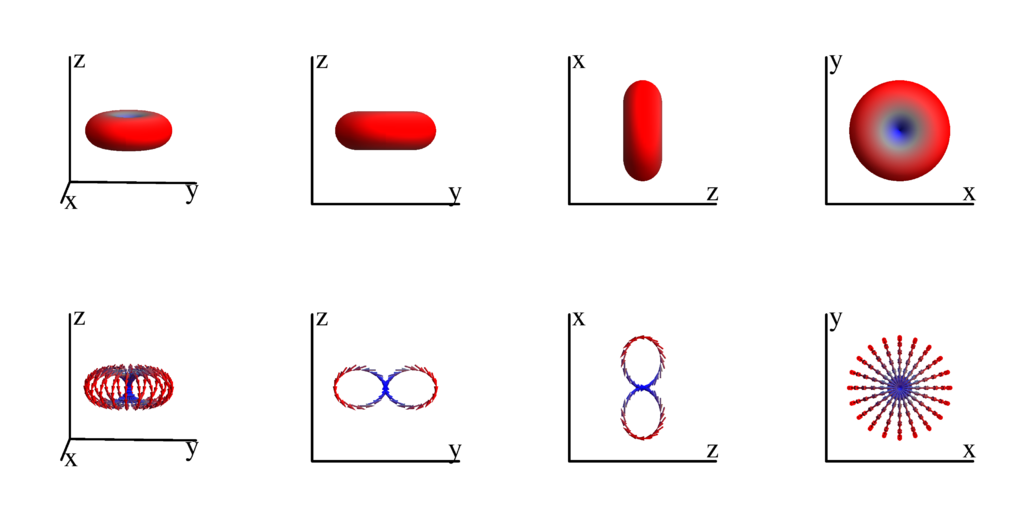
$j=\frac{5}{2}$
$j_z=-\frac{5}{2}$
$$J_{l=2, j=\frac{5}{2}}^{(j_z=-\frac{5}{2})}=\left( \begin{array}{c} \frac{1}{4} \sqrt{\frac{15}{2 \pi }} (x-i y)^2 \\ 0 \\ \end{array} \right)$$
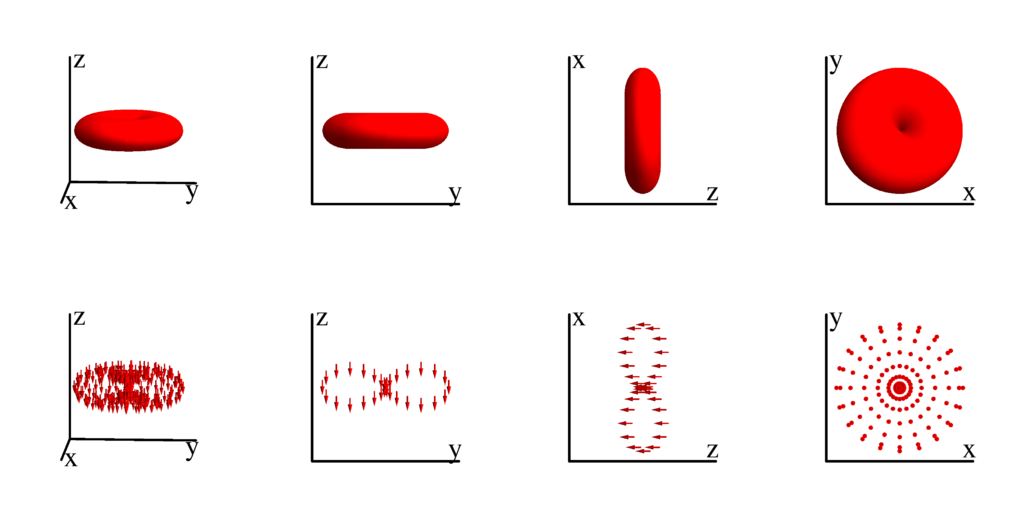
$j_z=-\frac{3}{2}$
$$J_{l=2, j=\frac{5}{2}}^{(j_z=-\frac{3}{2})}=\left( \begin{array}{c} \sqrt{\frac{3}{2 \pi }} z (x-i y) \\ \frac{1}{4} \sqrt{\frac{3}{2 \pi }} (x-i y)^2 \\ \end{array} \right)$$
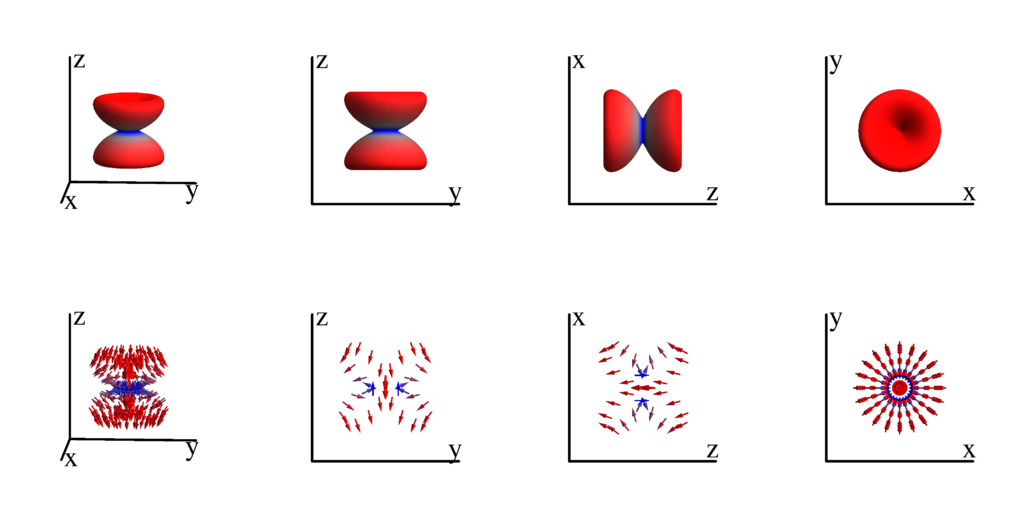
$j_z=-\frac{1}{2}$
$$J_{l=2, j=\frac{5}{2}}^{(j_z=-\frac{1}{2})}=\left( \begin{array}{c} -\frac{1}{4} \sqrt{\frac{3}{\pi }} \left(x^2+y^2-2 z^2\right) \\ \frac{1}{2} \sqrt{\frac{3}{\pi }} z (x-i y) \\ \end{array} \right)$$
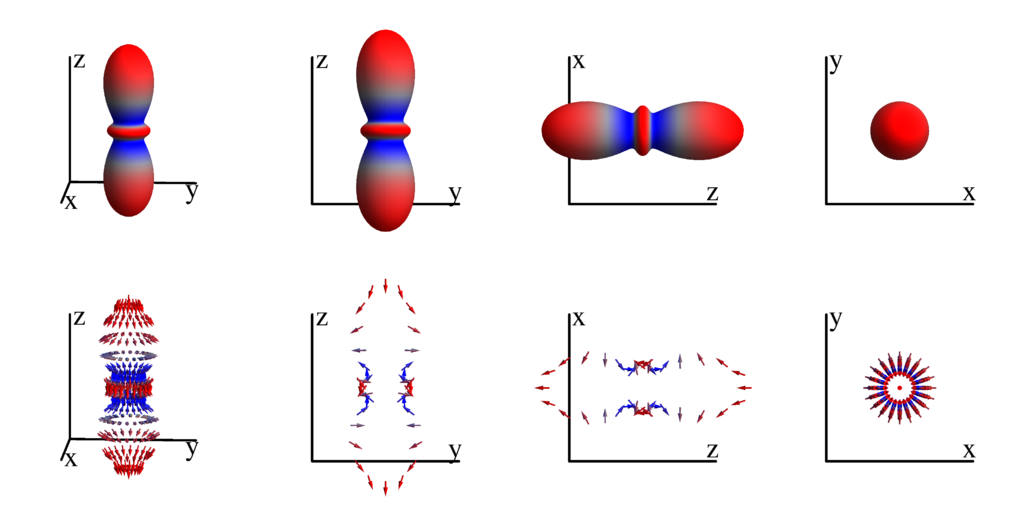
$j_z=\frac{1}{2}$
$$J_{l=2, j=\frac{5}{2}}^{(j_z=\frac{1}{2})}=\left( \begin{array}{c} -\frac{1}{2} \sqrt{\frac{3}{\pi }} z (x+i y) \\ -\frac{1}{4} \sqrt{\frac{3}{\pi }} \left(x^2+y^2-2 z^2\right) \\ \end{array} \right)$$
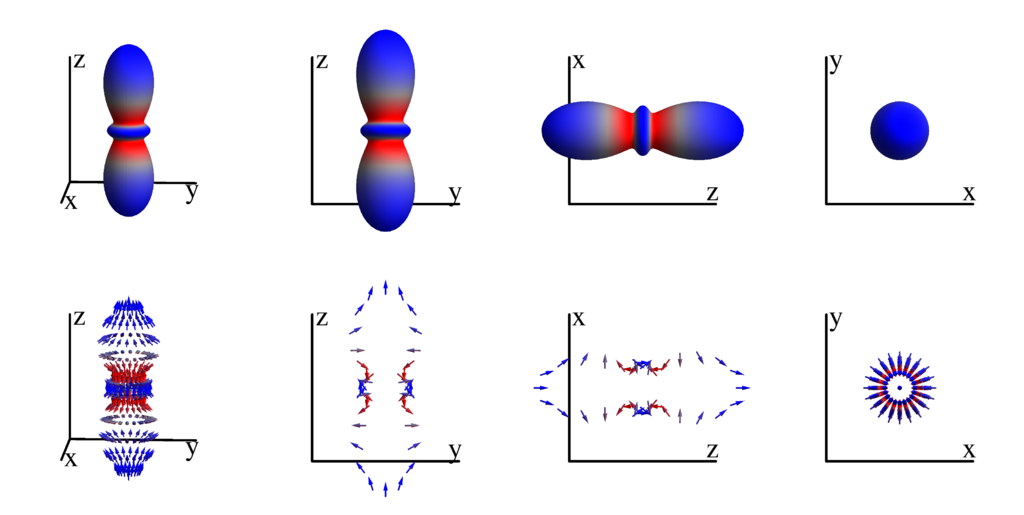
$j_z=\frac{3}{2}$
$$J_{l=2, j=\frac{5}{2}}^{(j_z=\frac{3}{2})}=\left( \begin{array}{c} \frac{1}{4} \sqrt{\frac{3}{2 \pi }} (x+i y)^2 \\ -\sqrt{\frac{3}{2 \pi }} z (x+i y) \\ \end{array} \right)$$
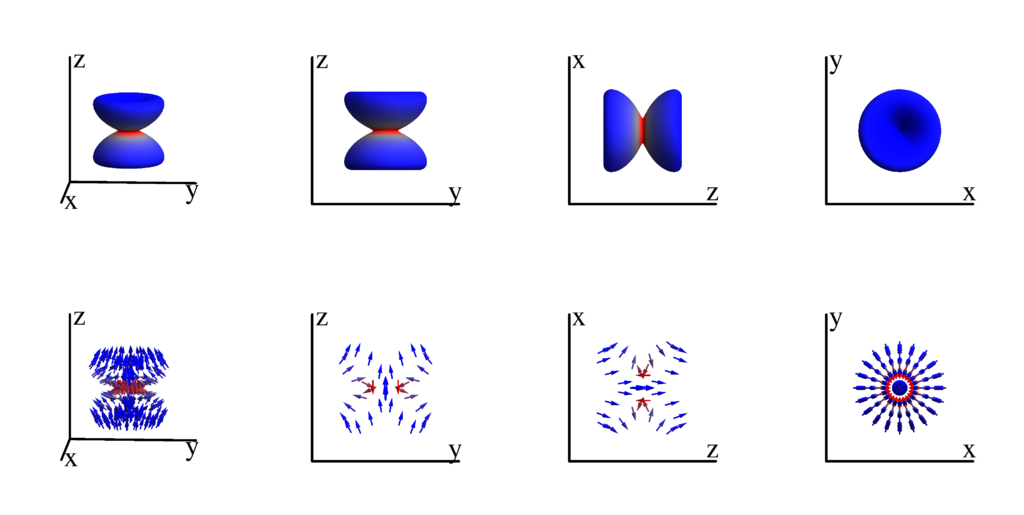
$j_z=\frac{5}{2}$
$$J_{l=2, j=\frac{5}{2}}^{(j_z=\frac{5}{2})}=\left( \begin{array}{c} 0 \\ \frac{1}{4} \sqrt{\frac{15}{2 \pi }} (x+i y)^2 \\ \end{array} \right)$$
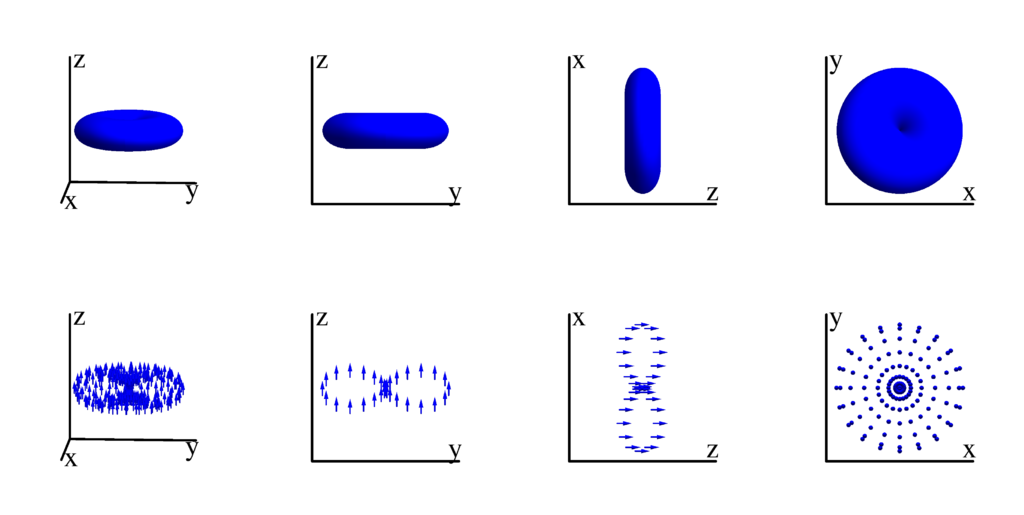
$l=3$
$j=\frac{5}{2}$
$j_z=-\frac{5}{2}$
$$J_{l=3, j=\frac{5}{2}}^{(j_z=-\frac{5}{2})}=\left( \begin{array}{c} \frac{1}{4} \sqrt{\frac{15}{2 \pi }} z (x-i y)^2 \\ -\frac{1}{4} \sqrt{\frac{15}{2 \pi }} (x-i y)^3 \\ \end{array} \right)$$
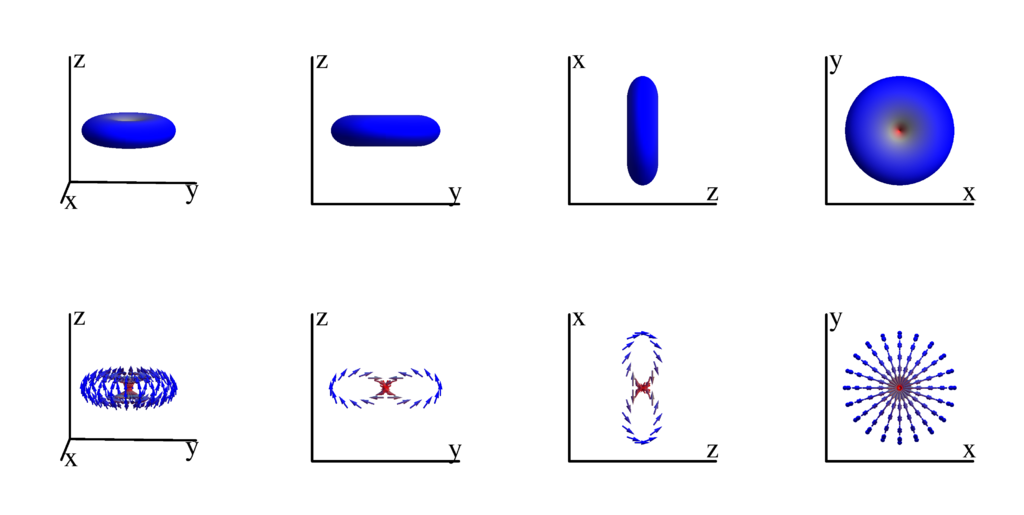
$j_z=-\frac{3}{2}$
$$J_{l=3, j=\frac{5}{2}}^{(j_z=-\frac{3}{2})}=\left( \begin{array}{c} -\frac{1}{4} \sqrt{\frac{3}{2 \pi }} (x-i y) \left(x^2+y^2-4 z^2\right) \\ -\frac{5}{4} \sqrt{\frac{3}{2 \pi }} z (x-i y)^2 \\ \end{array} \right)$$
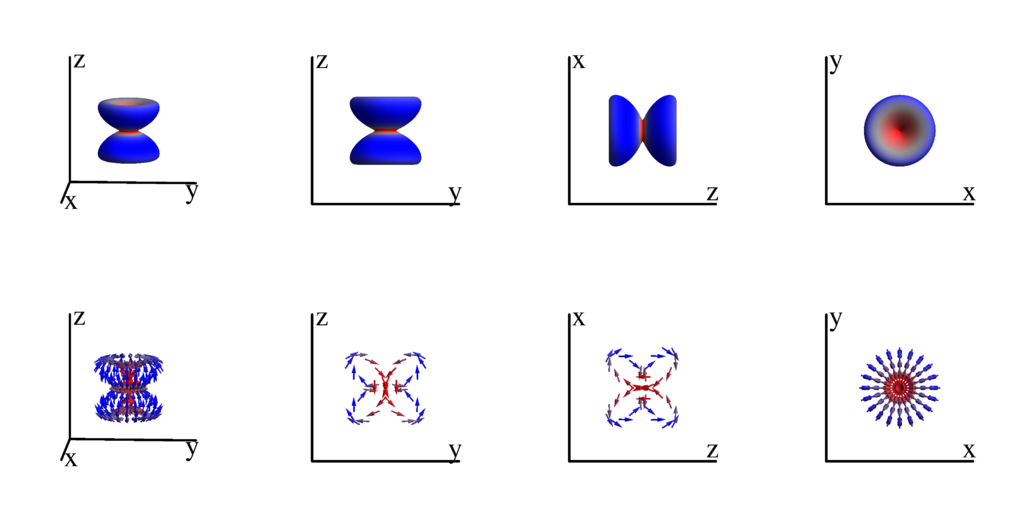
$j_z=-\frac{1}{2}$
$$J_{l=3, j=\frac{5}{2}}^{(j_z=-\frac{1}{2})}=\left( \begin{array}{c} \frac{1}{4} \sqrt{\frac{3}{\pi }} z \left(2 z^2-3 \left(x^2+y^2\right)\right) \\ \frac{1}{4} \sqrt{\frac{3}{\pi }} (x-i y) \left(x^2+y^2-4 z^2\right) \\ \end{array} \right)$$
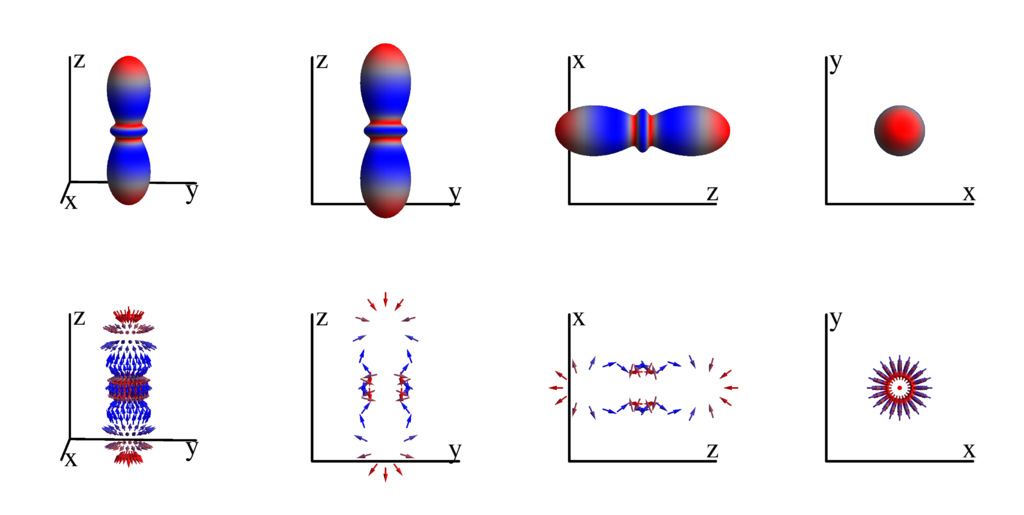
$j_z=\frac{1}{2}$
$$J_{l=3, j=\frac{5}{2}}^{(j_z=\frac{1}{2})}=\left( \begin{array}{c} \frac{1}{4} \sqrt{\frac{3}{\pi }} (x+i y) \left(x^2+y^2-4 z^2\right) \\ \frac{1}{4} \sqrt{\frac{3}{\pi }} z \left(3 \left(x^2+y^2\right)-2 z^2\right) \\ \end{array} \right)$$
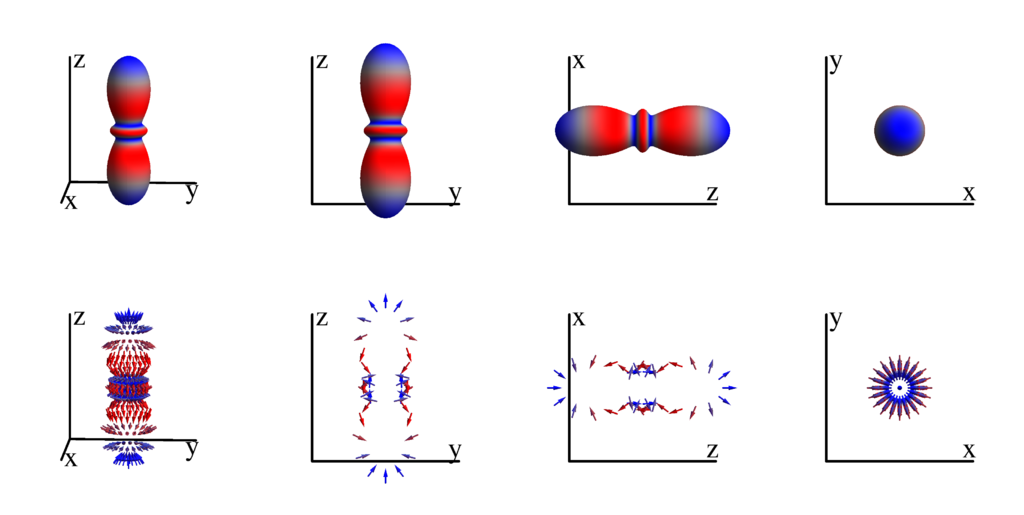
$j_z=\frac{3}{2}$
$$J_{l=3, j=\frac{5}{2}}^{(j_z=\frac{3}{2})}=\left( \begin{array}{c} \frac{5}{4} \sqrt{\frac{3}{2 \pi }} z (x+i y)^2 \\ -\frac{1}{4} \sqrt{\frac{3}{2 \pi }} (x+i y) \left(x^2+y^2-4 z^2\right) \\ \end{array} \right)$$
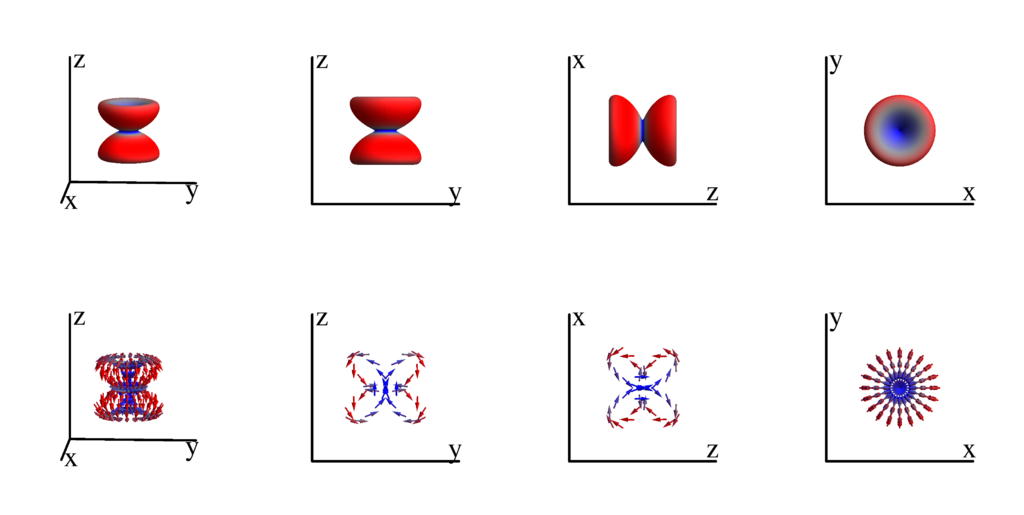
$j_z=\frac{5}{2}$
$$J_{l=3, j=\frac{5}{2}}^{(j_z=\frac{5}{2})}=\left( \begin{array}{c} -\frac{1}{4} \sqrt{\frac{15}{2 \pi }} (x+i y)^3 \\ -\frac{1}{4} \sqrt{\frac{15}{2 \pi }} z (x+i y)^2 \\ \end{array} \right)$$
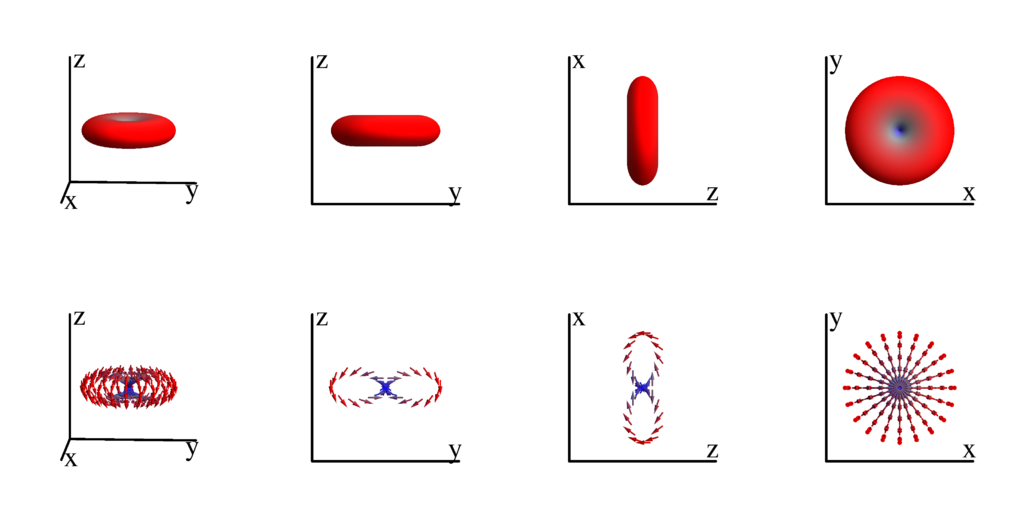
$j=\frac{7}{2}$
$j_z=-\frac{7}{2}$
$$J_{l=3, j=\frac{7}{2}}^{(j_z=-\frac{7}{2})}=\left( \begin{array}{c} \frac{1}{8} \sqrt{\frac{35}{\pi }} (x-i y)^3 \\ 0 \\ \end{array} \right)$$
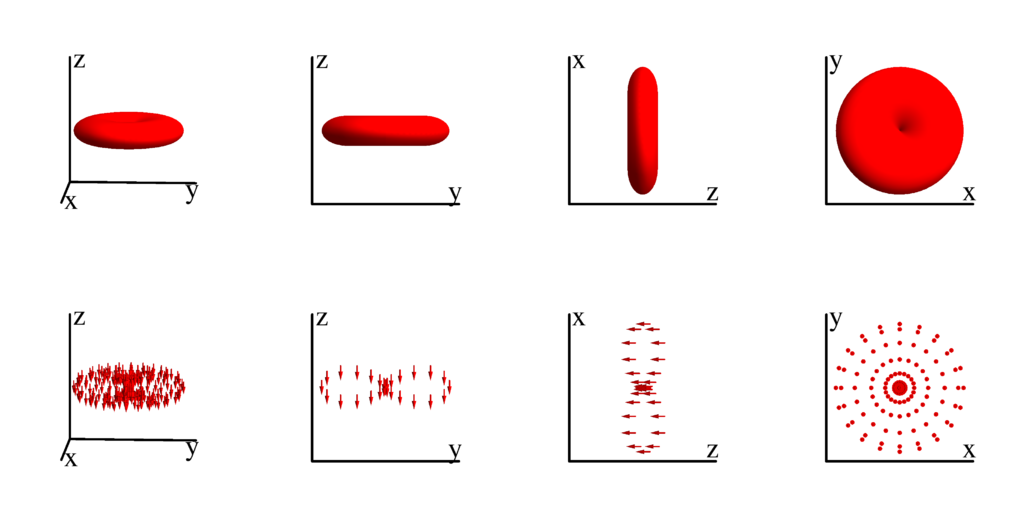
$j_z=-\frac{5}{2}$
$$J_{l=3, j=\frac{7}{2}}^{(j_z=-\frac{5}{2})}=\left( \begin{array}{c} \frac{3}{4} \sqrt{\frac{5}{\pi }} z (x-i y)^2 \\ \frac{1}{8} \sqrt{\frac{5}{\pi }} (x-i y)^3 \\ \end{array} \right)$$
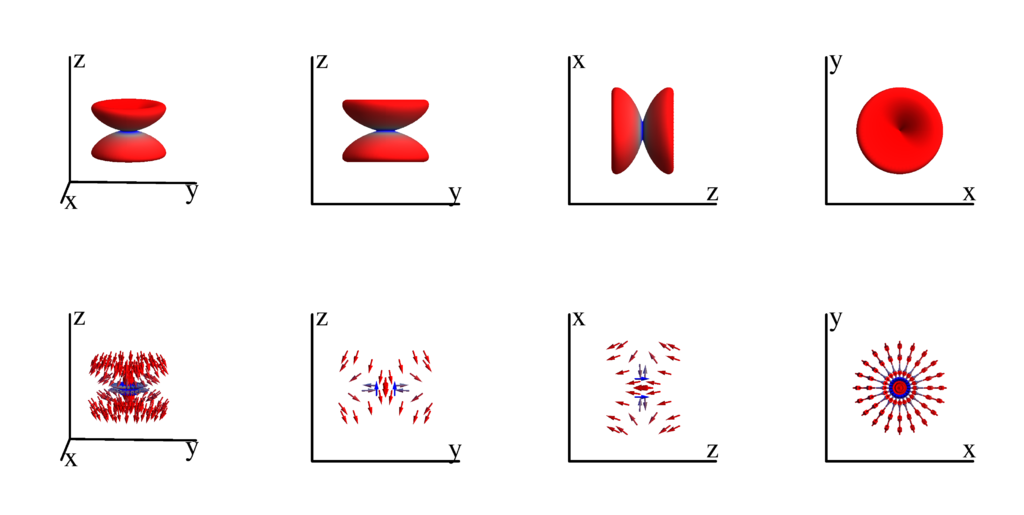
$j_z=-\frac{3}{2}$
$$J_{l=3, j=\frac{7}{2}}^{(j_z=-\frac{3}{2})}=\left( \begin{array}{c} -\frac{1}{8} \sqrt{\frac{15}{\pi }} (x-i y) \left(x^2+y^2-4 z^2\right) \\ \frac{1}{4} \sqrt{\frac{15}{\pi }} z (x-i y)^2 \\ \end{array} \right)$$
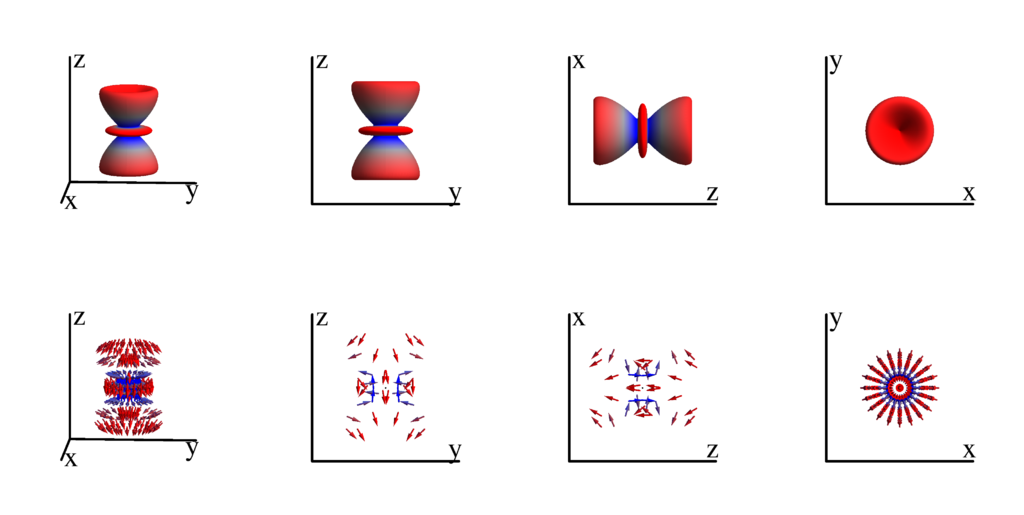
$j_z=-\frac{1}{2}$
$$J_{l=3, j=\frac{7}{2}}^{(j_z=-\frac{1}{2})}=\left( \begin{array}{c} \frac{2 z^3-3 z \left(x^2+y^2\right)}{2 \sqrt{\pi }} \\ -\frac{3 (x-i y) \left(x^2+y^2-4 z^2\right)}{8 \sqrt{\pi }} \\ \end{array} \right)$$
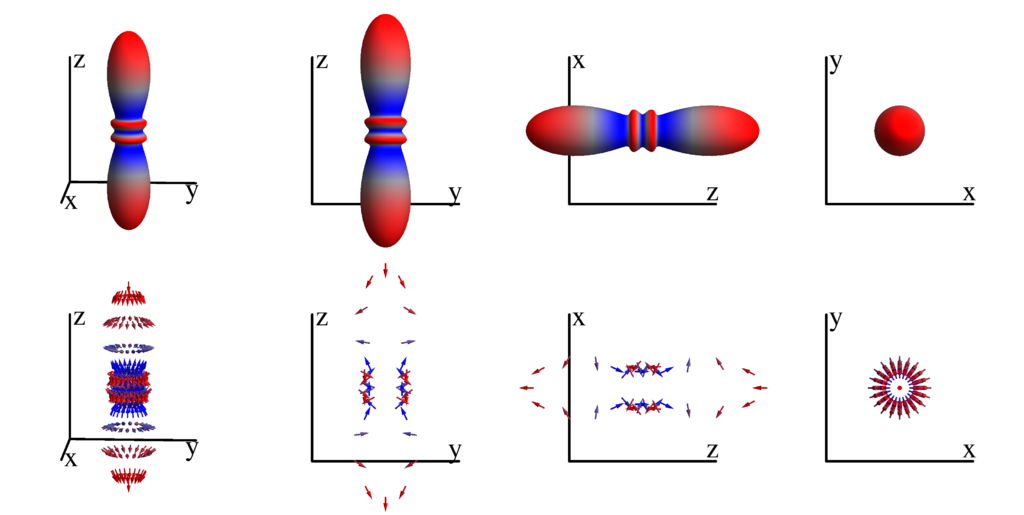
$j_z=\frac{1}{2}$
$$J_{l=3, j=\frac{7}{2}}^{(j_z=\frac{1}{2})}=\left( \begin{array}{c} \frac{3 (x+i y) \left(x^2+y^2-4 z^2\right)}{8 \sqrt{\pi }} \\ \frac{2 z^3-3 z \left(x^2+y^2\right)}{2 \sqrt{\pi }} \\ \end{array} \right)$$
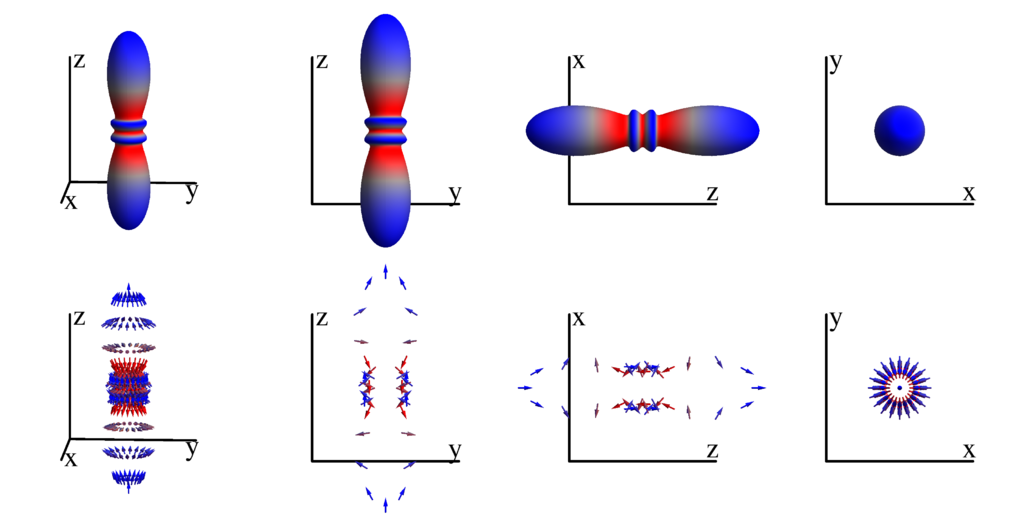
$j_z=\frac{3}{2}$
$$J_{l=3, j=\frac{7}{2}}^{(j_z=\frac{3}{2})}=\left( \begin{array}{c} \frac{1}{4} \sqrt{\frac{15}{\pi }} z (x+i y)^2 \\ \frac{1}{8} \sqrt{\frac{15}{\pi }} (x+i y) \left(x^2+y^2-4 z^2\right) \\ \end{array} \right)$$
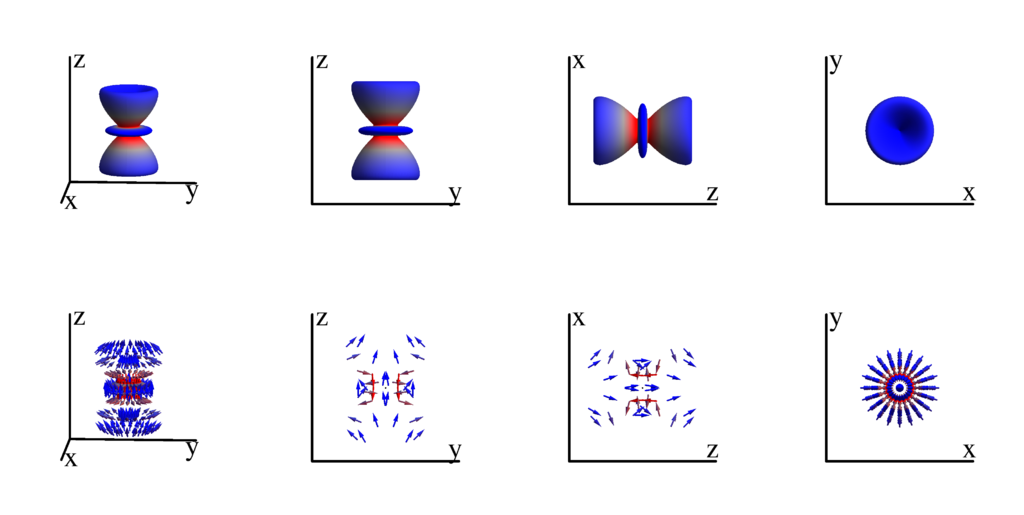
$j_z=\frac{5}{2}$
$$J_{l=3, j=\frac{7}{2}}^{(j_z=\frac{5}{2})}=\left( \begin{array}{c} -\frac{1}{8} \sqrt{\frac{5}{\pi }} (x+i y)^3 \\ \frac{3}{4} \sqrt{\frac{5}{\pi }} z (x+i y)^2 \\ \end{array} \right)$$
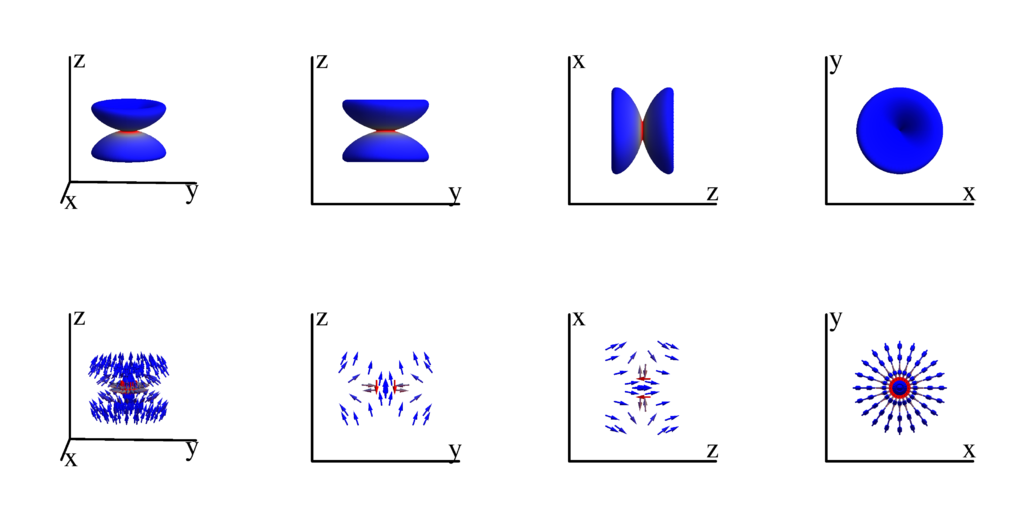
$j_z=\frac{7}{2}$
$$J_{l=3, j=\frac{7}{2}}^{(j_z=\frac{7}{2})}=\left( \begin{array}{c} 0 \\ -\frac{1}{8} \sqrt{\frac{35}{\pi }} (x+i y)^3 \\ \end{array} \right)$$
